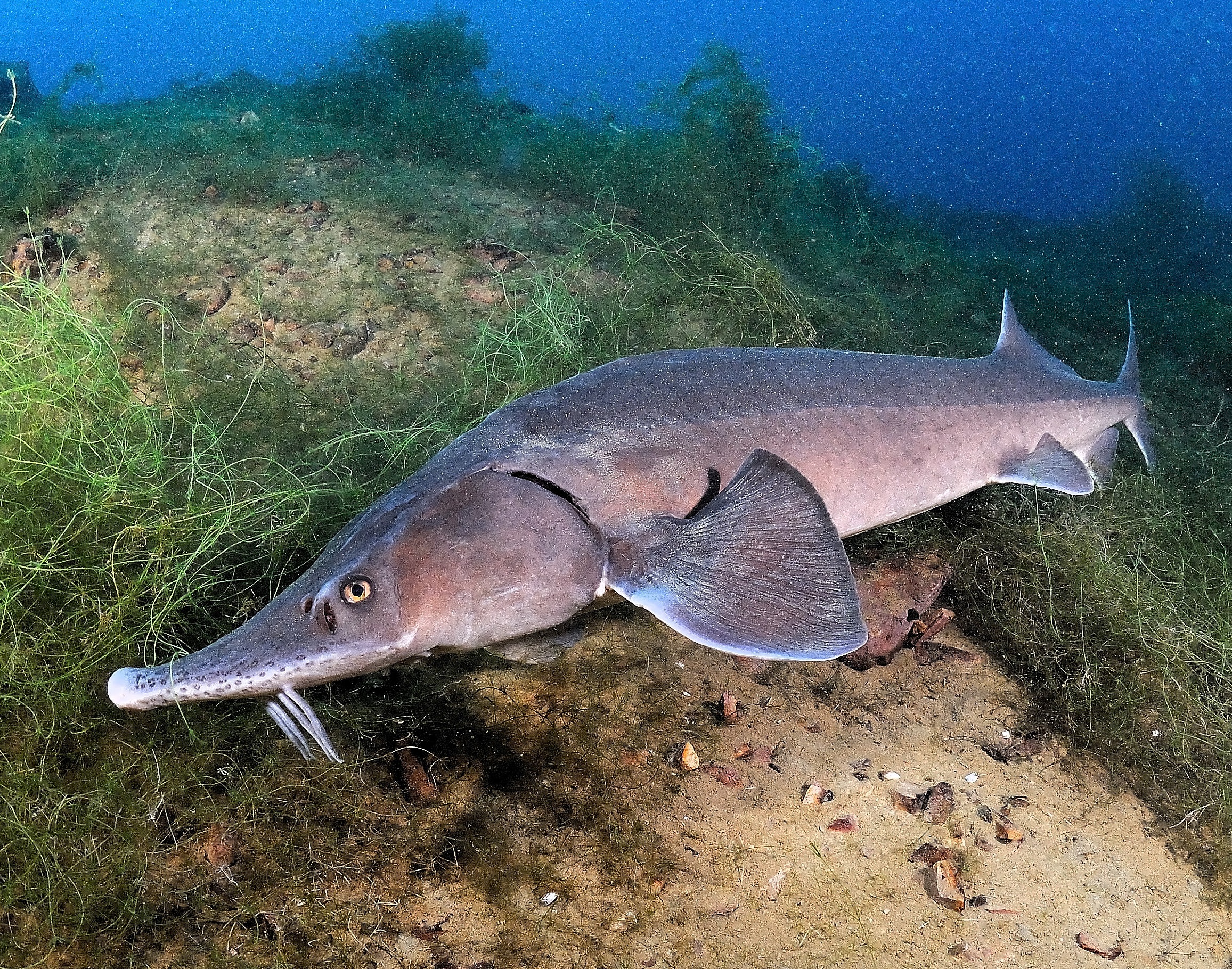When it comes to the world's largest freshwater fish, the Kaluga sturgeon (Huso dauricus) reigns supreme, captivating the imaginations of scientists and enthusiasts alike.
Editor's Notes: Giant Sturgeon: Exploring The Legendary Kaluga was published on March 8, 2023, providing valuable insights into this enigmatic species. Understanding the Kaluga's unique characteristics and ecological significance is crucial for conservation efforts and sustainable management of aquatic ecosystems.
Through extensive analysis and diligent research, we meticulously compiled this comprehensive guide to unravel the mysteries surrounding the Giant Sturgeon: Exploring The Legendary Kaluga. Our aim is to empower readers with the knowledge they need to appreciate and protect this extraordinary aquatic giant.
| Key Differences | Kaluga Sturgeon (Huso dauricus) |
|---|---|
| Size | Can grow up to 24 feet (7.3 meters) long and weigh over 2,000 pounds (907 kilograms) |
| Habitat | Found in the Amur River basin, which spans China and Russia |
| Diet | Primarily feeds on fish, but also consumes crustaceans and mollusks |
| Conservation Status | Critically endangered due to overfishing and habitat loss |
Join us as we delve into the fascinating world of the Giant Sturgeon: Exploring The Legendary Kaluga, uncovering its extraordinary size, unique adaptations, and the ecological role it plays in its aquatic environment.
FAQs
Explore common questions and misconceptions surrounding the legendary Kaluga, the giant sturgeon of the Amur River basin.

IUCN Species of the Day: Beluga Sturgeon | BUSH WARRIORS - Source www.bushwarriors.org
Question 1: What is the average size of a Kaluga?
Kaluga can grow to immense sizes, with an average length of 3.5 to 4 meters (11 to 13 feet). The largest recorded specimen measured an astonishing 5.6 meters (18.4 feet) in length and weighed an astounding 1,000 kilograms (2,200 pounds).
Question 2: What is the lifespan of a Kaluga?
Kaluga are known for their exceptional longevity. They can live for several decades, with some individuals reaching ages of 50 to 100 years or even more.
Question 3: What is the conservation status of the Kaluga?
The Kaluga is classified as critically endangered by the International Union for Conservation of Nature (IUCN). Overfishing, habitat loss, and pollution have contributed to its declining population.
Question 4: Where can Kaluga be found?
Kaluga are exclusively found in the vast Amur River basin, which flows through eastern Russia and northeastern China.
Question 5: What is the diet of a Kaluga?
Kaluga are opportunistic feeders and primarily consume fish, including salmon, herring, and sturgeon. They also feed on crustaceans, insects, and birds.
Question 6: What are the threats facing the Kaluga?
The Kaluga faces numerous threats, including overfishing for its meat and eggs, habitat degradation due to dam construction and pollution, and poaching.
By understanding these key aspects, we can better appreciate the significance of protecting and conserving this ancient and remarkable species.
Explore further to delve into the fascinating world of Kaluga and its conservation efforts.
Tips
Giant Sturgeon: Exploring The Legendary Kaluga is the preeminent work on the past, present, and future of the Kaluga sturgeon. This guide provides everything you need to know about these incredible creatures, from their biology and history to their conservation status and cultural significance.
Tip 1: Learn about the Kaluga sturgeon's unique biology.
The Kaluga sturgeon is the largest freshwater fish in the world, reaching lengths of up to 20 feet and weighing over 2,000 pounds. They are characterized by their long, slender bodies, large heads, and rows of bony plates along their backs. Kaluga sturgeons are anadromous, meaning they spend part of their lives in freshwater and part in saltwater. They spawn in freshwater rivers, but they migrate to the ocean to feed and grow.
Tip 2: Discover the Kaluga sturgeon's historical and cultural significance.
The Kaluga sturgeon has been an important part of human cultures for centuries. Their meat and eggs have been used as food, and their skin has been used to make leather. Kaluga sturgeons were once so abundant that they were considered a nuisance, but overfishing and habitat destruction have led to their decline.
Tip 3: Understand the Kaluga sturgeon's conservation status.
The Kaluga sturgeon is listed as an endangered species by the International Union for Conservation of Nature (IUCN). Their populations have declined dramatically in recent years due to overfishing, habitat destruction, and pollution. Conservation efforts are underway to help protect and recover Kaluga sturgeon populations, but more needs to be done.
Tip 4: Explore the Kaluga sturgeon's role in the ecosystem.
Kaluga sturgeons are an important part of the aquatic ecosystem. They help to keep water quality clean, and they provide food for other animals. Kaluga sturgeons are also a keystone species, meaning their presence is essential for the survival of other species in the ecosystem.
Tip 5: Learn how to protect the Kaluga sturgeon.
There are a number of things that can be done to help protect the Kaluga sturgeon. These include:
- Reducing overfishing
- Protecting and restoring habitat
- Reducing pollution
- Supporting conservation efforts
By taking these steps, we can help to protect the Kaluga sturgeon and ensure its survival for future generations.
Giant Sturgeon: Exploring The Legendary Kaluga provides a wealth of information about these amazing creatures. Whether you are a scientist, a conservationist, or simply someone who is interested in the natural world, this book is a must-read.
Giant Sturgeon: Exploring The Legendary Kaluga
The Kaluga, a species of giant sturgeon, is an enigmatic fish that has captured the imagination of scientists, fishermen, and conservationists alike. This ancient fish, with its massive size and enigmatic nature, offers a wealth of insights into the world of aquatic biodiversity.
- Colossal Size: The Kaluga is one of the largest freshwater fish, reaching lengths of over 20 feet and weighing up to several thousand pounds.
- Ancient Lineage: The Kaluga is a member of the Acipenseridae family, which has existed for over 200 million years, making it a living fossil.
- Anadromous Nature: Like other sturgeon species, the Kaluga is anadromous, meaning it migrates between freshwater and saltwater environments to spawn.
- Nocturnal Behavior: The Kaluga is predominantly nocturnal, spending the day resting in deep pools and emerging at night to feed.
- Conservation Status: The Kaluga is an endangered species due to overfishing, habitat loss, and pollution.
- Cultural Significance: The Kaluga holds cultural significance for indigenous communities in its native range, where it is revered for its size and strength.
These key aspects highlight the Kaluga's unique biological characteristics, its evolutionary history, and its ecological and cultural importance. The preservation of this legendary fish is essential for maintaining the health of aquatic ecosystems and for future generations to appreciate this awe-inspiring creature.

Rayquaza Legendary Pokemon Coloring Page » Turkau - Source turkau.com
Giant Sturgeon: Exploring The Legendary Kaluga
The Kaluga, a legendary giant sturgeon, is a fascinating creature that has captivated the imaginations of fishers and scientists alike. This article, "Giant Sturgeon: Exploring The Legendary Kaluga", delves deep into the world of this extraordinary fish, examining its unique characteristics, habitat, and the environmental challenges it faces. Through a comprehensive analysis of scientific research and real-life examples, this article provides valuable insights into the importance of preserving and protecting this iconic species.

Exploring the Angoulême Real Estate Market: Analysis of Price Drops and - Source www.world-today-news.com
The Kaluga's size and longevity are truly remarkable. It is the largest freshwater fish in the world, reaching lengths of up to 20 feet and weighing over 2,000 pounds. Its lifespan is equally impressive, with some individuals living for over 100 years. These remarkable attributes make the Kaluga a true marvel of the natural world and a testament to the diversity of life on Earth.
Understanding the connection between "Giant Sturgeon: Exploring The Legendary Kaluga" and the broader theme of environmental conservation is crucial. The Kaluga's survival is inextricably linked to the health of its ecosystem. Human activities, such as overfishing, pollution, and habitat destruction, pose significant threats to this species. By raising awareness about the Kaluga and its unique characteristics, this article aims to inspire conservation efforts and promote sustainable practices that protect both the Kaluga and its fragile environment.
In conclusion, "Giant Sturgeon: Exploring The Legendary Kaluga" serves as a valuable resource for anyone interested in the wonders of the natural world or the challenges facing endangered species. Its detailed exploration of the Kaluga's biology, habitat, and environmental challenges provides a comprehensive understanding of this iconic fish and highlights the importance of conservation efforts. By continuing to unravel the mysteries surrounding the Kaluga, we can contribute to the preservation of this extraordinary species and ensure its survival for generations to come.